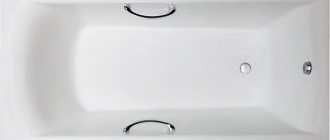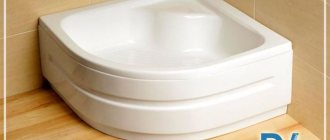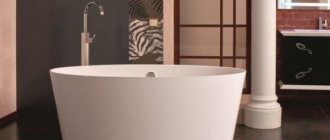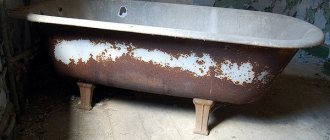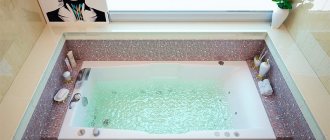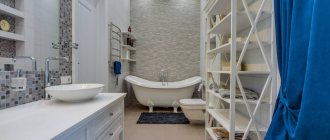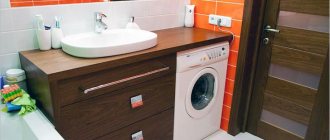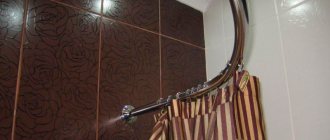The times when manufacturers and hardware stores offered 2-3 standard models of plumbing fixtures are long gone. Now the counters delight the eye with products that differ in price category, color, shape and the presence of additional functions.
This diversity makes it possible to obtain the use of advanced materials and new technologies for their processing. An asymmetrical bathtub is the last word in design, an object that sets the mood and style of the entire interior. A cast iron or acrylic washing container of an unconventional shape helps to rationally use the free space in the room and increases the comfort of performing hygiene procedures. In this article we will talk about asymmetrical bathtubs, what types and sizes they are produced.
Advantages and disadvantages
- An attractive appearance that allows you to transform a room beyond recognition.
- Suitable for small rooms, products are ordered according to individual parameters.
- The presence of an additional ledge for taking a bath while sitting. The option is also comfortable for tall people.
- With the emergence of a large number of manufacturers, placing an order for an asymmetrical bathtub has become easier.
Among the disadvantages of the product, it is worth highlighting possible deformation under the weight of the consumer. In addition, over time, the material wears out, so do not save money; choose models from trusted manufacturers.
How to determine dimensions
The determining factor in your choice is solely the area of the bathroom, or rather, the usable space that the bowl will occupy.
Before you buy a specific bathtub model, you need to clearly think through the complete layout of the room. Think about what equipment and furniture will be in the room where it will be located, take into account communications. Next, determine the exact location for the bathtub.
Every nuance, right down to the laundry basket, is very important, because then it will be quite difficult to choose a cozy corner and a bathtub model. You should go to the store with approximate dimensions of the area.
Remember, an asymmetrical bathtub (most likely a corner one) requires a significant part of the area; it’s not just a rectangular piece, because this type of plumbing is the largest and it is what determines the design of the bathroom.
The issue of sizing is the most important part in choosing an asymmetrical design. The main size indicates the dimensions of the sides of the bowl (width and length).
The most common parameter is 130 cm for a corner bath. Such asymmetrical bathtubs can be equipped with hydromassage, air jets and other functions.
When choosing, you should pay attention to its size
After determining the angular dimensions, pay attention to the overall length and width of the product, which are also indicated in centimeters. There is no need to remind you once again that this data is extremely important, because they determine how correctly and comfortably a new corner or any other asymmetrical bathtub will be installed.
Please note that many built-in products may have a hexagonal shape. Such a product can cause many problems during installation, but its dimensions are even more important for installation.
Standard sizes
The corner baths we know can be installed in a room of absolutely any size. After all, modern manufacturers offer us asymmetrical bathtubs of completely different sizes: a corner bathtub can reach 185 cm in length.
A triangular-shaped bathtub has a certain advantage: when installed, the bowl uses only one corner, and the second can be used for installing other plumbing fixtures or furniture. In addition, even just an empty area of the room already looks much better, freer and more spacious.
Almost all sizes of corner models provide space for placing bath accessories, personal cosmetics or seating.
Corner baths always provide space for seating or bath accessories.
The second advantage is their diversity. Bowl shapes can be asymmetrical or symmetrical. The sizes of such products vary from 120 cm to 185 cm. If the parameters exceed 200 cm, you can consider that you are purchasing a home pool.
In addition, corner baths are produced with both left-hand and right-hand connections, which greatly simplifies the selection and installation process.
Classic sizes of corner baths from famous manufacturers:
- Ravak company: 140x105 cm, 150x75 cm, 150x100 cm, 150x105 cm, 160x75 cm, 160x105 cm, 170x105 cm, 170x110 cm, 185x105 cm.
- Teiko: 150x100 cm, 160x75 cm, 160x90 cm, 160x100 cm, 160x105 cm, 160x125 cm, 180x130 cm.
- Kolo company: 140x100 cm, 150x100 cm, 160x80 cm, 160x100 cm, 170x105 cm.
All data is for asymmetrical bathtubs. As you can see, the variety of dimensions is great and you can choose one for any room.
The same names of manufacturers can offer you symmetrical bathtubs, the parameters of which are also varied. The range of sizes varies from 125x125 cm to 150x150 cm. But remember, this is just a range, and you can choose any parameter within the above figures.
The dimensions determine the main property of non-standard bathtubs: the complete lack of symmetry.
Types of asymmetrical bathtubs and their characteristic features
Asymmetrical bathtubs are classified according to production material, shape, size, and the presence of additional functionality.
By material
- Cast iron - retains heat for a long time and is considered reliable. Consumers do not like the material due to its heavy weight and installation complexity. The average weight is 130-150 kilograms. The top of the product is not enamel, but a polymer coating, which is distinguished by its affordable cost and ergonomic shape.
- A steel bathtub will last at least 30 years, and weighs 40 kilograms, which simplifies the process of transportation and installation. The characteristics are similar to acrylic models. They are often equipped with armrests, handrails, and hydromassage.
- Acrylic asymmetrical bathtubs are in demand. The material guarantees:
- a light weight;
- noiselessness;
- possibility of surface restoration;
- making products to order;
- attractive appearance.
The only disadvantages are the difficulty of care and reaction to sudden temperature changes, but this most likely refers to low-quality material.
- Bathtubs made of copper can be classified as exclusive models. They look beautiful, the presence of antibacterial properties of natural material. But they are not popular and are expensive.
By shape
The opportunity to experiment with shapes was given to manufacturers by such a material as acrylic. The following variations are available on the market:
- triangular;
- with a rounded or straight base;
- trapezoidal;
- with straight or broken configuration;
- polygonal;
- combined.
In addition, a product of any shape can be made to order. Due to their refractoriness, cast iron models are limited in the choice of shapes.
By size
Most modern models are equipped with additional stripes or seating sections, which increases the dimensions. When choosing a product for the bathroom, it is worth studying the dimensions of the room. Keep in mind that large products place a greater load on the floor. Based on size, products are divided into:
- Small-sized models with a length of 120-130 cm are used for small rooms.
- Standard options are 150-160 cm long, created for standard apartments and houses.
- The length of large-sized products is 170-200 cm, which increases the cost and requires space for installation.
Functional equipment
Asymmetrical models offer the following additional features:
- hydro and air massage units;
- elements for storing bathroom accessories;
- water purification system;
- receiver;
- built-in telephone.
To make using the functionality more comfortable, the bathtubs are equipped with a remote control.
Angled or straight
The two sides are connected at right angles.
One of the sides of the corner asymmetrical bathtub is no longer than 1 meter. The length of the second is 130-170 cm. The end side is convex or curved. Such models are available in right-hand and left-hand versions. The corner product is suitable for small rooms.
An asymmetrical model with a direct accent looks like an angular one, but is more like a trapezoid, where:
- two straight corners;
- one side is beveled or rounded and the rest are straight.
Height from floor
The standard height from the floor is 60 cm. This standard allows you to comfortably use the bathing container. The height is safe for entering and exiting the bathroom.
Permissible deviation 50-70 cm.
By type of fastening
- Using a support frame. Metal supports are used for acrylic and steel models with thinner walls. With this type of fastening, installing the bowl at any height and securing it securely is not difficult.
- With legs that can be easily adjusted in height. The support does not rise above 15-20 cm.
- The podium is created using bricks or blocks. This option prevents the possibility of deformation and guarantees the stability of the model.
Shape Features
Traditional shapes used to make bathtubs are symmetrical. More often, washing containers are made in the form of a rectangle with rounded corners or an oval. The emergence of new materials has made it possible to create complex products whose shape resembles a triangle, trapezoid, or polygon. Such models are considered asymmetrical, since their halves are different from each other. The advantages of asymmetrical bathtubs are:
- High level of comfort. The asymmetrical shape allows you to equip a comfortable, spacious place for washing, their size, volume and depth allow even a tall person to comfortably accommodate.
A very comfortable stay in such a bathroom - Ergonomics. An asymmetrical acrylic, cast iron or steel bathtub is equipped with built-in armrests, handrails, and headrests, making the bowl ergonomic and comfortable.
- Saving free space. The dimensions and volume of asymmetrical bathtubs allow you to save free space in small rooms, which are typical for typical old-style multi-storey buildings. With their help, you can equip a spacious washing area even in very cramped conditions.
- Aesthetics. Asymmetrical bathtubs give the room a modern look, organizing the space around it. An acrylic or cast iron washing container of a non-standard shape becomes the central accent of the interior, adding some futurism to it.
Note! An asymmetrical bathtub is a technological product, the production of which requires high-quality material and expensive equipment. The most common model of this type is considered to be an acrylic washing container, since this material can easily take any shape.
The best manufacturers of custom bathtubs
- Czech company Ravak with extensive experience in the production of acrylic products. The company started with the production of shower trays and expanded its product line. The catalog contains about 70 options costing from 8 to 80 thousand rubles.
- The Polish manufacturer Cersanit is considered a more budget-friendly option, where on average the products will cost 15,000 rubles.
- Riho - a company from Holland provides consumers with simple bathtub shapes and non-standard designs. Almost all products have a ribbed anti-slip coating. The cost of products varies from 10 to 50 thousand rubles. A model with a capacity of 600 liters will cost 46,300 rubles and requires a large placement area.
- Domestic manufacturer Triton issues a 10-year product warranty. An acrylic asymmetrical corner model will cost 10 thousand rubles. The company has recently been producing handmade bathrooms - non-standard and more expensive.
- The products of domestic brands BAS and Akrilan inspire no less confidence. An ordinary asymmetrical bathtub will cost 10-15 thousand rubles, but for the presence of hydromassage nozzles you will have to pay the same amount.
How to install an asymmetrical corner bath?
An example of an asymmetrical bathtub on a factory frame
Installing an asymmetrical bathtub is a labor-intensive process. That is why most people prefer the work of professionals from the relevant companies. Although knowledge of basic construction and repair skills facilitates independent installation.
- First you need to read the attached installation instructions. It should be included with the selected asymmetrical bathtub. The instructions, as a rule, indicate the complete set, as well as a list of all parts needed for installation.
- Before starting installation, prepare the place where the bathtub will subsequently stand. Carefully inspect the floor for evenness and the walls for smoothness. If suddenly something does not meet the requirements for installing a bathtub, start adjusting the surfaces. All detected defects and cracks must be repaired with plaster or using a leveling mixture. The leveling of the surface is dictated by the design feature of the model itself.
- If you find mold and mildew, then do not be lazy and treat the area prepared for the bath with antiseptics (can be bought at any hardware store).
Take note: If you are installing a specific model, for example, a corner asymmetrical acrylic bathtub measuring 140x90 cm, then all measurements for it must be made in advance - before finishing the surfaces and corners. Forced dismantling has never made anyone happy.
Installation of this type of corner bath can be carried out using the following two methods - using legs and by laying a foundation.
- Only when the bathtub is completely installed and perfectly dry can you connect it to the communications. Along the perimeter of contact between the bathtub and the walls, special sides are attached, and the existing gaps are filled with silicone material.
- The last point is to install an elastic plinth on top of the sides, which is made of a special waterproof material.
A bathroom with an asymmetrical bathtub is a bold decision, but don’t be afraid to take risks and the result will not disappoint you.
Advantages of an unusual custom shape
The product is created according to individual parameters, so it will definitely suit even a non-standard room. Bold ideas are easy to bring to life. We are talking not only about sizes and shapes, but also about the additional functionality of the product. Of course, you have to pay extra for such a bathroom, but only you will have the exclusivity.
Modern tendencies
Previously, most consumers preferred cast iron and steel bathtubs. Now the situation has changed radically, and most people are trying to purchase models that are made of acrylic.
This material is characterized by excellent technical and operational characteristics, and is also significantly cheaper than metal or cast iron.
In addition, the use of acrylic in the manufacture of a bathtub allows the manufacturer to experiment with shape and size. Asymmetrical corner bathtubs made of acrylic do not require any additional maintenance. They have the same heat capacity as metal or cast iron bathtubs, but at the same time have a relatively low weight, which facilitates the installation process. And cleaning such a bathtub is a pleasure. Thanks to the smooth surface, there is practically no contamination on it.
The plasticity of this material allows us to produce not only rectangular and corner bathtubs. In a wide range you can find models of round, oval, square and even polygonal shapes. But the leader still remains the corner asymmetrical bathtub.
Advice from experts on what to look for when choosing
- Products from foreign manufacturers use millet due to its reliability and long service life. Choose Germany or Italy.
- Take into account the features of the reinforcing layer, which should not be less than 5 mm. Lower values are one of the reasons for the appearance of cracks and deformations from the weight of a person and strong water pressure.
- When choosing a model with additional functionality, try to make sure that each one works.
- When installing an asymmetrical steel bathtub, take care of sound insulation.
- Corner models are more spacious, because it is easy to place bathroom accessories in a place near the wall.
- The model with hydromassage requires a network connection. The socket is grounded and has a cover to protect it from water.
An asymmetrical bathroom is the best solution for those who like to stand out and surprise with an original style. In addition to its attractive appearance, the product is a practical solution for small spaces. Every centimeter is put to good use. Thanks to the wide variety of models depending on materials, sizes and functionality, each consumer will choose the appropriate option. The investments made will pay off after the first bath.
Steel models
An asymmetrical steel bathtub is produced by the manufacturer more often than cast iron, but not as actively as acrylic. Steel is processed quite easily, so using a press this material can be given different shapes. Such models are budget options, their service life is 15-20 years. The weak point of steel washing containers is the enamel, which cracks, deforms, and chips during use due to vibration of the walls.
Steel bath
Despite their low cost, they have the following useful qualities:
- A light weight. Asymmetrical steel bathtubs, despite their large dimensions, weigh very little. Light weight greatly facilitates the transportation and installation of equipment made from this material.
- Affordable price. An asymmetrical model made of steel will cost the homeowner less than an acrylic or cast iron one, which is why such products are popular, despite their scarcity.
- Variety of sizes. The light weight of the alloy and the flexibility of the alloy make it possible to manufacture products of any size and volume.
- Reliability. The combination of wear resistance and impact resistance of the material makes steel washing containers one of the most practical.
Experienced craftsmen note that when using steel bathtubs, especially during water intake, the walls of the product vibrate strongly, greatly increasing the noise. To reduce this unpleasant effect, you should purchase models with a thickness of 3.5 mm. You can reduce the resonating ability and thermal conductivity of steel by treating the bottom of the bowl with foam or other insulating material.
A few words about baths
The plumbing equipment market today offers consumers a wide range of modern bathtubs. They differ in the material from which they are made, in size, shape, and, accordingly, in pricing policy. The presence of additional functions, such as hydromassage, etc., also plays an important role in determining the cost.
The most popular materials for making bathtubs are: cast iron, steel, polymer materials and natural stone. There are also bathtubs made of wood and glass, but such plumbing is often used in country houses and not in apartments.
Acrylic bathtubs: a popular new product
An asymmetrical acrylic bathtub appeared on the sanitary equipment market relatively recently, but the demand for these products is growing very quickly. Asymmetrical acrylic bathtubs are characterized by the following indicators:
- Weight. An acrylic bathtub is much lighter than products made of cast iron and steel;
- The lineup. Due to the plasticity and lightness of the material, manufacturers can offer square, round, corner and polygonal models;
- Wear resistance. This factor is characterized by the fact that the pigment for painting is introduced into the polymer mass, which prevents the paint from rubbing off;
- Fast restoration. All scratches that appear due to careless use can be easily eliminated using special treatment of the top layer;
- Availability of accessories and decorative elements. Only an asymmetrical bathtub allows you to experiment with all sorts of additions. This could be lighting or hydromassage, an additional side and other details;
- Internal asymmetry. In such bathtubs, headrests, armrests, all kinds of recesses, niches and shelves are possible inside.
In order for an asymmetrical acrylic bathtub to serve you for many years and truly become the decoration of your bathroom, you need to pay special attention to the characteristics of each model. So, say, a bathtub with an abundance of fancy lines and complex relief designs can bring not only joy, but also a lot of trouble. A too pretentious shape is evidence that the walls of this product are very thin, which means that a low-quality polymer could have been used.
